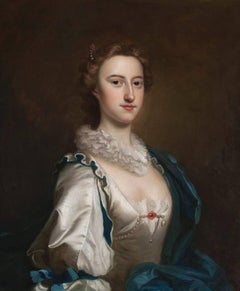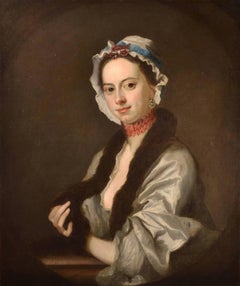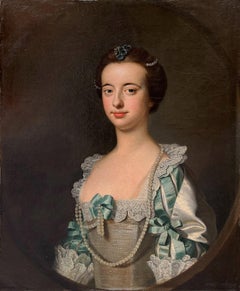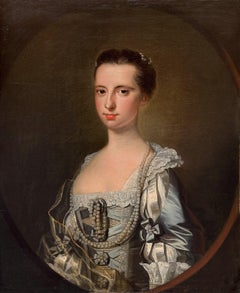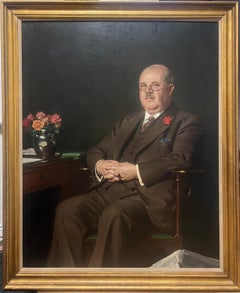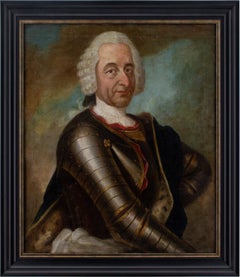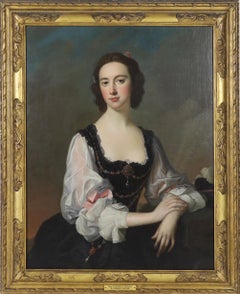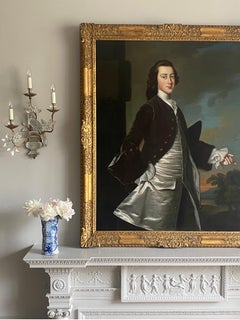Thomas Hudson Art
to
4
Overall Width
to
Overall Height
to
4
3
1
2
2
2
2
1
1
1
4
4
4
4
4
8,244
2,807
1,643
1,319
2
4
Artist: Thomas Hudson
Portrait of a Lady, Old Masters 18th Century Oil
By Thomas Hudson
Located in London, GB
Thomas Hudson
1701 – 1779
Portrait of a Lady
Oil on canvas
Image size: 30 x 25 inches
Original carved giltwood frame
Hudson had many assistants, and employed the specialist drapery ...
Category
18th Century Old Masters Thomas Hudson Art
Materials
Canvas, Oil
Portrait of Mrs Faber, 18th Century Oil Painting
By Thomas Hudson
Located in London, GB
THOMAS HUDSON
1701 – 1779
Portrait of Mrs Faber
Oil on canvas
Image size: 29 x 24 ½ inches
Contemporary gilt frame
Mrs Faber was the wife of John Faber J...
Category
18th Century and Earlier Thomas Hudson Art
Materials
Canvas, Oil
Portrait of Lady Mansfield of Ringwood
By Thomas Hudson
Located in London, GB
Portrait of Lady Mansfield of Ringwood
Oil on Canvas
Image size: 25 x 30 inches (63 x 76 cm)
Original carved & gilded frame
POA
Provenance
Descended through the Family Estate
Born in Poland in 1760 to the 2nd Earl of Mansfield and his wife, Elizabeth Mary Murray would later come under the care of her uncle, William Murray (1st Earl of Mansfield) at Kenwood House in Hampstead. David Murray (2nd Earl of Mansfield) was set to inherit the title and full wealth of his uncle, including Kenwood House. Lady Mansfield’s second cousin would soon join her at Kenwood, where they would be raised together and featured in multiple portraits of the time. Her younger sister, Henrietta, is seen in a separate portrait done by Thomas Hudson as well. At the age of 25 she married George Finch-Hatton, an English aristocrat and politician who sat in the House of Commons from 1772-1784.
Gazing out at the viewer, Lady Mansfield wears a decorated dress, with an abundance of pearls and lace, and a transparent gold lined veil surrounding her right shoulder. The excess of luxurious fabric matches another Hudson portrait of another Lady Mansfield, with the lace detailing and complementary bodice. The depiction of this Lady Mansfield epitomizes the style of portraiture in the 18th century, such as the styles Hudson’s pupils Joshua Reynolds, Joseph Wright, and Peter Toms. From Hudson’s travels to the Low Countries and Italy, he no doubt brought back artistic inspiration from the international pieces he encountered.
Thomas Hudson
Hudson was a celebrated 18th century portrait painter. Born in Devon in 1701 he studied under the artist Jonathan Richardson and married his daughter, against Richardson’s wishes.
He had many artistic friends including William Hogarth and Francis Hayman and travelled with them in Europe in 1748. He also visited Italy with the sculptor Louis-François Roubiliac in 1752. Hudson’s style of portraiture proved so successful that for a decade from 1745 to 1755 he was London’s most popular portrait painter and made a fortune painting the cream of London society and members of the Royal Family.
He was also a talented teacher, perhaps too good, as subsequently a number of his former assistants overtook him in popularity including the artist Joshua Reynolds.
Hudson retired in the late 1750’s and died in Twickenham in 1779. His most notable works include portraits of King George II and George Friedrich Handel and his “Portrait of a Nobleman in Van Dyck dress.” Many of Hudson’s works may be seen in art galleries. These include the National Portrait Gallery, the National Maritime Museum, the Tate Gallery, the Foundling Museum and the Bristol City Museum and Art Gallery. His works are also in Museums across the world...
Category
18th Century English School Thomas Hudson Art
Materials
Canvas, Oil
Price Upon Request
Portrait of Lady Mansfield of Ringwood
By Thomas Hudson
Located in London, GB
Portrait of Lady Mansfield of Ringwood
Oil on Canvas
Image size: 25 x 30 inches (63 x 76 cm)
Original carved & gilded frame
POA
Provenance
Descended through the Family Estate
The y...
Category
18th Century English School Thomas Hudson Art
Materials
Canvas, Oil
Price Upon Request
Related Items
Huge British Mid 20th Century Portrait of a Bank Manager Signed Oil Painting
Located in Cirencester, Gloucestershire
The Bank Manager
by Stuart Scott Somerville (1908-1983)
signed oil on canvas, framed
Framed: 56 x 47 inches
Canvas: 50 x 40 inches
Provenance: private collection, UK
Condition: very ...
Category
Mid-20th Century English School Thomas Hudson Art
Materials
Oil, Canvas
Mid-18th-Century German School, Portrait Of An Aristocrat In Armour
Located in Cheltenham, GB
This mid-18th-century half-length German portrait depicts a middle-aged aristocrat wearing armour and a wig.
Despite his heavily-clad appearance, it’s likely that this rather noncha...
Category
1750s Old Masters Thomas Hudson Art
Materials
Canvas, Oil
Portrait of a Lady in Red Dress on Porch c.1680, English Aristocratic Provenance
Located in London, GB
Presented by Titan Fine Art, this painting formed part of a historic collection of an English aristocratic family, Lord and Lady Sandys at their magnificent baroque and Regency Grade-I listed family home, Ombersley Court. The house was among the most fascinating survivals of its kind in this country. The atmospheric interiors were distinguished above all for the works of art associated with two key moments in national history. The collection was acquired or commissioned over five centuries and remained at Ombersley Court until its recent sale, the first in 294 years. This portrait hung in the Grand Hall.
This exquisite grand manner work is an evocative example of the type of portrait in vogue during a large part of the seventeenth and eighteenth centuries. The artist has depicted an elegant lady, three quarter length and seated on porch with a luxurious crimson swag curtain by her side. The clothing – known as “undress” at the time, consists of red silk fastened at the front and sleeves by large gold and diamond jewels over a simple white chemise. In her lap she holds a blue wrap and in her other hand, at her chest, she clutches the end of a sheer gauzy scarf that has been draped around her body with the other end a type of headdress – this type of sheer scarf was often employed by Wissing in his portraits. The classical architecture signifies cultivation and sophistication and the luxurious swag curtain is a signifier of wealth. The portrait can be dated to circa 1680 based on the sitter’s attire, the “hurluberlu” hairstyle, and other portraits by Wissing using the same formula.
This oil on canvas portrait has been well cared for over its life, which spans almost 350 years. Having recently been treated to remove an obscuring discoloured varnish, the finer details and proper colour can now be fully appreciated.
Once owned by Evesham Abbey, the manor of Ombersley was acquired by the Sandys family in the early 1600s, when Sir Samuel Sandys, the eldest son of Edwin Sandys, Bishop of Worcester and later Archbishop of York, took a lease on the manor, before receiving an outright grant in 1614. The present house, Ombersley Court, dates from the time of Samuel, 1st Lord Sandys, between 1723 and 1730. The house itself is a fine example of an English Georgian country house set in rolling countryside and surrounded by Wellingtonias, planted to commemorate the Battle of Waterloo by Arthur Hill, 2nd Baron Sandys, who played a distinguished part in the battle and was one of the Duke of Wellington’s aides de camp. The Duke also stayed in the house and in the Great Hall, was the Waterloo banner which was brought to the house by Sir Arthur Hill, aide-de-camp to the Duke of Wellington, who succeeded his mother, the Marchioness of Downshire as 2nd Lord Sandys. Further Waterloo memorabilia are kettle drums from battle. The family had a strong tradition of military and political service, dating back to the 17th century, and this was also reflected in the fine collection of portraits and paintings in the house. In short, Ombersley represented a vital aspect of British history. The house and more especially the collection were of the greatest historical importance. Houses that have remained in the possession of the same family for as many as three centuries have become increasingly rare.
Through this portrait, collectors have a chance to acquire a piece of British history and an evocative vestige of a glittering way of life, which is now gone.
Much of the attractiveness of this portrait resides in its graceful manner and the utter beauty of the youthful sitter. Presented in a beautiful carved and gilded period frame, which is a work of art in itself.
Willem Wissing was a Dutch artist who enjoyed a solid artistic training at The Hague under Arnold van Ravesteyn (c.1650-1690) and Willem Dougijns (1630-1697). He came to London in 1676 and most probably joined the studio or Sir Peter Lely as an assistant that same year. After Lely’s death in 1680 he effectively took over his business and he scaled the heights of patronage with extraordinary ease, creating an independent practise in 1687, and painted for very important aristocratic patrons. King Charles II was so impressed by a portrait Wissing painted of his son, the Duke of Monmouth, in 1683 that he commissioned his own portrait and that of his Queen Catherine...
Category
17th Century Old Masters Thomas Hudson Art
Materials
Canvas, Oil
On Hold
$13,696
H 57.09 in W 47.25 in D 2.37 in
Portrait of Catherine Murray, Countess of Dysart, Roses, Gilded Frame, Van Dyke
By Anthony van Dyck
Located in London, GB
This exquisite Grand Manner work, presented by Titan Fine Art, is an evocative example of the type of portrait in vogue during the seventeenth and eighteenth centuries. Beautifully ...
Category
17th Century Old Masters Thomas Hudson Art
Materials
Canvas, Oil
On Hold
$19,814
H 59.45 in W 51.19 in D 3.94 in
Portrait of Lady Catherine Edwin (Montagu) in a Woodland c.1697; Fine Provenance
By Michael Dahl
Located in London, GB
This exquisite portrait, presented by Titan Fine Art, is by Michael Dahl; it was part of the extensive collection owned by Thomas Wyndham of Clearwell Court in Gloucestershire. It ma...
Category
17th Century Old Masters Thomas Hudson Art
Materials
Canvas, Oil
On Hold
$23,290
H 54.93 in W 40.95 in D 2.76 in
Fine Large 1800's English Oil Country Gentleman in Parkland before Stately Home
Located in Cirencester, Gloucestershire
The English Gentleman and his Country House
English artist, circa 1800-1820 period
Fine Georgian period portrait of a young English gentleman, seated with distant view of his country...
Category
Early 19th Century English School Thomas Hudson Art
Materials
Oil, Canvas
$2,761 Sale Price
30% Off
H 36 in W 28 in
19th century portrait of a spaniel dog in a landscape, a country house beyond
By Charles Bilger Spalding
Located in Bath, Somerset
A 19th century black and white spaniel standing in a landscape, with a country house in the distance. Signed C B Spalding, lower right.
Oil on canvas in a giltwood frame.
Charles B...
Category
19th Century English School Thomas Hudson Art
Materials
Canvas, Oil
$3,875 Sale Price
20% Off
H 16.34 in W 22.45 in
Portrait of a Gentleman in Scarlet Robe Holding Flowers c.1675, Oil on canvas
Located in London, GB
Titan Fine Art present this striking portrait, which was painted by one of the most talented artists working in England during the last half of the 17th century, John Greenhill. Gre...
Category
17th Century Old Masters Thomas Hudson Art
Materials
Canvas, Oil
On Hold
$11,054
H 55.12 in W 44.1 in D 2.37 in
George Clint ARA (Attributed), Portrait Of A Lady In A Brown Dress
Located in Cheltenham, GB
This early 19th-century half-length portrait attributed to British artist George Clint ARA (1770-1854) depicts a young lady wearing a beautiful brown dress, bonnet decorated with small flowers, gold earrings and coral necklace. Clint was a distinguished painter and mezzotint engraver predominantly known for portraiture and dramatic scenes.
Set before an evocative classically-inspired backdrop, she looks out from across the centuries with a composed demeanour. Adorned in the latest fashions, oversized ‘gigot’ sleeves, a delicately-poised bonnet, and a coral necklace for good luck. It’s a charming portrayal by a masterful hand.
Born at Drury Lane, in the heart of London’s West End, George Clint was destined to lead an exuberant life amid the spectacle of theatreland. His father, Michael Clint, was a hairdresser during a time of “hair pomatum, whalebone, wire, lace gauze, and feathers” - so young George would have encountered a variety of ‘characters’ during his childhood.
But despite these elevated surroundings, he soon discovered the darker side of London when thrust into the world of employment. Apprenticed initially as a fishmonger, he trained under a ferocious master who was known to beat him. The hours were unsocial, the conditions rank, and the work was brutal. He soon quit but subsequently found himself toiling for a corrupt attorney who demanded he undertake unscrupulous acts on his behalf.
Seeking a less volatile role, he turned next to house painting, at which he excelled. Commissioned, among other projects, to paint the stones of the arches in the nave of Westminster Abbey. Aside from an incident whereby he almost fell from the second story of a building, all was going well.
Following his marriage in 1792 to Sarah Coxhead, a farmer’s daughter, he began work in earnest as a painter of miniatures, determined to forge a career. Robert William Buss’ memoir celebrates Clint’s success as a miniaturist, stating that “great manual excellence was united with that chaste, delicate feeling for female beauty which characterised all Mr. Clint's portraits of ladies.”
Until this point, it appears he was predominantly self-taught, presumably constrained by a lack of finances. But from hereon in, his industrious nature coupled with several fortunate encounters, led to him developing an enviable talent for both painting and engraving. During the early 19th-century, the acquaintances one kept could make or break your fortunes and perhaps acutely aware of this, Clint’s ‘society’ was an ever-evolving circle of influential personalities.
He was “initiated into the mysteries of engraving” by Edward Bell (act.1794-1819) and produced numerous works after the foremost artists, such as George Stubbs, John Hoppner, and Thomas Lawrence. Following a commission from Lawrence, he struck up a long-term friendship.
Admired for his skill as a mezzotint engraver, he sought next to hone his technique in oils and, as with many aspiring portraitists, his first work in this respect was a depiction of his beloved wife. The pair were both delighted with it, yet over time Clint began to doubt himself and sought the validation of a superior hand - that of Sir William Beechey (1753-1839). However, paralysed with insecurity, he couldn’t face the potential criticism, so his wife took it instead - “with a child under one arm and the portrait in the other”. The result was immeasurably more positive than he’d envisaged and he became closely associated with Beechey until his death in 1839.
Numerous commissions followed from the landed gentry including Lord Egremont, Lord Spencer, and Lord Essex. But also from the theatrical community who would fill his studio at 83 Gower Street, Bloomsbury. His connections within the world of acting led to notable works such as ‘Malvolio and Sir Toby’ (from William Shakespeare's 'Twelfth Night', Act II, Scene iii)’ and ‘Harriet Smithson as Miss Dorillon, in Wives as They Were, and Maids as They Are’.
While his efforts in mezzotint included several contributions to JMW Turner’s Liber Studiorum.
As a measure of his success, Clint was elected an Associate of the Royal Academy in 1821 - a position he later relinquished for personal reasons. Today, he’s represented in numerous public collections including at The British Museum, Harvard Art Museums, The Met, V&A, Yale Center for British Art, and the National Portrait Gallery.
“The respect in which he was held, not only by his brother artists, but by an immense number of eminent men in various professions, and others of the highest rank, was the result of a rare combination of talent, candour, suavity of manner, and integrity of purpose”. [Obituary, 1854].
Housed in a period gilt frame, which is probably original.
Learn more about George Clint ARA in our directory.
Labels & Inscriptions: Supplier’s stencil from Rowney & Forster. The National Portrait Gallery holds a database of supplier’s stencils over the decades. The one here is also presented on two other works by George Clint. ‘Falstaff’s Assignation with Mrs Ford...
Category
1830s English School Thomas Hudson Art
Materials
Oil, Canvas
17th century Dutch Old Master Portrait of a boy with his dog - Dutch golden age
Located in Aartselaar, BE
Dutch 17th century old master portrait of a boy, accompanied by his playful dog, blowing bubbles
This captivating portrait shows a young boy who is looking at the spectator with ey...
Category
Mid-17th Century Old Masters Thomas Hudson Art
Materials
Oil, Canvas
$42,380
H 33.86 in W 28.15 in D 0.79 in
Portrait of Gentleman Blue & Cloak, Portrait of Lady, Fine Carved Gilded frames
Located in London, GB
Portrait of a Gentleman with Blue Cloak and Portrait of a Lady in Russet Dress c.1697
Thomas Murray (1663-1735)
These fascinating portraits are exquisite examples of portraiture in ...
Category
17th Century Old Masters Thomas Hudson Art
Materials
Oil, Canvas
$28,157
H 37.8 in W 33.47 in D 2.76 in
Fine 1820's English Georgian Large Portrait of a Country Lady seated with Quill
Located in Cirencester, Gloucestershire
Portrait of a Country Lady, depicted Seated wearing a silk glove and with a Quill Pen
English artist, circa 1820's, unsigned
oil on canvas, unframed
canvas: 35 x 29 inches
provenance...
Category
Early 19th Century English School Thomas Hudson Art
Materials
Oil, Canvas
Previously Available Items
18th century portrait of Miss Furneaux-Pelham
By Thomas Hudson
Located in Bath, Somerset
Portrait of a Miss Furneaux Pelham, in a 'Van Dyck' style black gown with white sleeves trimmed with pink ribbon, the bodice adorned with jewels and pearls, resting her arm on a stone pedestal.
Bears a Christie's stencil on the reverse 629HT and a Sotheby's auction chalk mark.
Oil on canvas housed in a period giltwood frame.
Canvas size: 92 x 71cm
In frame: 109 x 89cm
Provenance:
Property of Edward Hockley when sold at Christie's London, 3 May 1946, lot 79 (as by Allan Ramsay), bt. by 'Nicholl'
Sotheby's London sale, 'British Paintings 1500-1805', 10 July 1991, lot 22 (as by Thomas Hudson)
Private collection, Sussex
From 1740 to about 1760 Thomas Hudson was one of the most successful portrait painters in England. Having come to London in the mid-1720's, shortly after the death of Sir Godfrey Kneller in 1723, Hudson gradually rose to a position of prominence, which he held until the 1750's. Hudson painted only portraits, working first under the influence of his teacher Jonathan Richardson, and then turning in the 1740's to the baroque portrait compositions of Sir Anthony Van Dyck and Sir Peter Lely. From this time, with the assistance of drapery painters such as Joseph Van Aken, Hudson produced large numbers of portraits of ladies, gentlemen, judges and clergymen.
He married his teacher's daughter Mary...
Category
18th Century English School Thomas Hudson Art
Materials
Canvas, Oil
English 18th century portrait of Walter Edwards Freeman (c.1725-1747)
By Thomas Hudson
Located in Bath, Somerset
Walter Edwards Freeman, three-quarter length, standing in a landscape (probably the grounds of Batsford Park) wearing a dark green velvet jacket with gold buttons and a white cravat, an ivory silk waistcoat with his hat tucked under his arm, his hair worn 'en queue'. Oil on canvas.
Walter Edwards Freeman (born circa 1725) was the son of Mary (nee Freeman) and Walter Edwards Senior whose family came from Bristol. Mary's father was Richard Freeman (Senior), a landowner with extensive properties in several counties and was appointed Lord Chancellor of Ireland in 1702. After the death of his uncle, Richard Freeman (the Younger) in 1745, he inherited the estate of Batsford Park, Gloucestershire, and he and his family took the surname Freeman. Sadly Walter died two years later and his brother Thomas then inherited the Batsford Estate. When Thomas died without a direct heir in 1808, the estate passed on to his wife's nephew John Mitford and so on through the Mitford family. In 1916 it was inherited by the eccentric David Freeman-Mitford, 2nd Baron Redesdale and father of the famous Mitford sisters. His eldest daughter, Nancy Mitford, based part of her novels 'The Pursuit of Love' and 'Love in a Cold Climate' on their time living at Batsford.
Provenance:
The property of a Mrs E. Redburn when sold with Sotheby's London, 23 November 1977
With Lane Fine Art, London
The property of Eric Dare, Melbourne, Australia when sold with Sotheby's, 13 November 1995.
Christie's London, British Pictures, 24 November, 1998, lot 27
From 1740 to about 1760 Thomas Hudson was one of the most successful portrait painters in England. Having come to London in the mid-1720's, shortly after the death of Sir Godfrey Kneller in 1723, Hudson gradually rose to a position of prominence, which he held until the 1750's. Hudson painted only portraits, working first under the influence of his teacher Jonathan Richardson, and then turning in the 1740's to the baroque portrait compositions of Sir Anthony Van Dyck and Sir Peter Lely. From this time, with the assistance of drapery painters such as Joseph Van Aken, Hudson produced large numbers of portraits of ladies, gentlemen, judges and clergymen. He married his teacher's daughter Mary Richardson...
Category
Mid-18th Century English School Thomas Hudson Art
Materials
Canvas, Oil
Portrait of an Aristocratic Gentleman in Crimson Velvet Jacket Oil Painting
By Thomas Hudson
Located in Cirencester, Gloucestershire
Portrait of an Aristocratic Gentleman
attributed to Thomas Hudson (British 1701-1779)
oil painting on canvas, framed
canvas: 30 x 25 inches
framed: 33 x 28 inches
provenance: private collection, England
Fine 18th century English oil painting...
Category
18th Century Old Masters Thomas Hudson Art
Materials
Canvas, Oil
English 18th century Portrait of a Lady wearing blue silk
By Thomas Hudson
Located in Bath, Somerset
A rare signed portrait of a young lady by Thomas Hudson (1701-1779) circa 1736. Inscribed lower right 'D.G. 18 years' and signed 'Hudson'.
Size 41½” x 31” (105.5 x 79 cms)
Oil on c...
Category
Early 18th Century Old Masters Thomas Hudson Art
Materials
Oil, Canvas
H 41.54 in W 31.11 in
Thomas Hudson - Pair of portraits - 4th Duke of Beauforts children
By Thomas Hudson
Located in Stoke, Hampshire
Thomas Hudson 1701-1779
The eldest children of Charles Noel, 4th Duke of Beaufort: Head and shoulders portraits of Henry (1744-1803; later 5th Duke) a little boy dressed in blue Van Dyck costume, and his sister Lady Anne Somerset, (1741-1763) in a white dress set with pink ribbons, and a lace ruff.
Oil paintings on canvas each 20 x 15 inches in carved and giltwood frames
Painted circa 1747/8
Thomas Hudson, a native of Devon, was by far the leading portrait painter in London for two decades in the middle years of the 18th century. He had arrived in London in the 1720’s after the death of Sir Godfrey Kneller, who had dominated London society portraiture for decades. He was taught to paint portraits by the redoubtable Jonathan Richardson, the artist, connoisseur, collector and theoretician of the arts.
His portrait practice by 1740 was substantial and highly successful, and numerous paintings by him survive. He continued the tradition of Van Dyck and Lely, and maintained a large studio with numerous talented young artists whom he taught: Henry Pickering, Joseph Wright of Derby, Sir Joshua Reynolds and others. He usually employed Joseph Van Aken as his drapery painter, and the consequence is that many of the works of these artists in these two decades are often difficult to distinguish one from another.
His quality, though, is consistent, and his likenesses truthful: they are the sound Georgian Prose and may be contrasted with the feathery rococo poetry of painters of the next generation, most notably Gainsborough.
The present paintings illustrate the high fashion of the 1750-60's, when the “Van Dyck” falling lace collar enjoyed a substantial, if rather brief, popularity. Hudson used the style on numerous occasions for both male and female sitters. The present pictures are autograph replicas of two of the group of portraits by Hudson of the 4th Duke's children painted towards the end of the 1740's, and which remain at Badminton House...
Category
18th Century Thomas Hudson Art
Materials
Oil
Thomas Hudson art for sale on 1stDibs.
Find a wide variety of authentic Thomas Hudson art available for sale on 1stDibs. You can also browse by medium to find art by Thomas Hudson in canvas, fabric, oil paint and more. Much of the original work by this artist or collective was created during the 18th century and earlier and is mostly associated with the Old Masters style. Not every interior allows for large Thomas Hudson art, so small editions measuring 25 inches across are available. Customers who are interested in this artist might also find the work of John Emms, W. Smithson Broadhead, and John Horace Hooper. Thomas Hudson art prices can differ depending upon medium, time period and other attributes. On 1stDibs, the price for these items starts at $24,293 and tops out at $25,307, while the average work can sell for $24,540.
